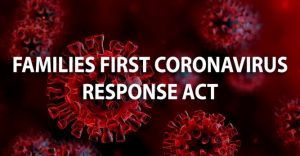 The Families First Coronavirus Response Act (FFCRA) requires all private (i.e., non-government) employers with fewer than 500 employees to provide emergency paid sick leave and emergency paid FMLA leave to employees who need leave due to the COVID-19 public health emergency. Employers (other than federal and state employers) will receive a tax credit equal to 100% of the money they spend on the paid leave mandated under the law.
The Families First Coronavirus Response Act (FFCRA) requires all private (i.e., non-government) employers with fewer than 500 employees to provide emergency paid sick leave and emergency paid FMLA leave to employees who need leave due to the COVID-19 public health emergency. Employers (other than federal and state employers) will receive a tax credit equal to 100% of the money they spend on the paid leave mandated under the law.
- The law is in effect from April 1, 2020 until December 31, 2020.
- There are also some state &/or local laws that create employer obligations for paid sick time.
- Employers with 500 or more employees are not covered under the FFCRA.
- Employers with 500 or more employers may very well at some point have a paid leave mandate as a result of additional actions by Congress.
RULES FOR HOW TO COUNT EMPLOYEES
The US Department of Labor (DOL) has issued a rule addressing this issue.
- Only US-based employees count toward the 500-employee threshold, including employees in US territories and possessions. Employers may count employees on leave, jointly employed employees, and day laborers supplied by a temporary agency, but not independent contractors.
- If a corporation has an ownership interest in another corporation, the two corporations are separate for purposes of counting toward the 500-employee threshold unless they are joint employers under the FLSA.
THE MANDATE
The FFCRA includes the requirement to provide 10 days of emergency paid sick leave in a new freestanding law that incorporates several provisions of the Fair Labor Standards Act (FLSA). The FFCRA includes the requirement to provide emergency Family and Medical Leave Act (FMLA) leave for 12 weeks (of which 10 weeks must be paid) as an amendment to the existing FMLA.
ELIGIBLE EMPLOYEES
- Full-time and part-time employees are eligible for the short-term paid sick leave (emergency paid sick leave), regardless of when an employee started working for the employer.
- Full-time and part-time employees are eligible for the long-term paid leave (emergency FMLA leave). However, to be eligible, the employee must have been employed for at least 30 days. Employees who were laid off on or after March 1, 2020, but were subsequently rehired are also eligible for emergency FMLA leave, so long as the employee worked for 30 of the last 60 days before the layoff.
-
- An employer of healthcare providers or emergency responders has the option of excluding an employee who is a healthcare provider or emergency responder from the emergency paid sick leave and/or the emergency FMLA leave.
- The Secretary of Labor has issued a rule defining “healthcare provider” for this provision of the law as anyone employed by a wide range of healthcare institutions and businesses and anyone employed by an entity that contracts with such institutions.
EXEMPTION FOR SMALL EMPLOYERS FOR ONE TYPE OF LEAVE
You will also be able to lead a normal deeprootsmag.org buy cheap levitra life with the confidence for performing well sexually whenever he wants to.
Here are the exemptions:
- The FFCRA provided the Secretary of Labor authority to exempt businesses with fewer than 50 employees from providing leave if an employee needed to care for a child if a school or place of care was closed, or if the child’s care provider was unavailable for a reason related to COVID-19.
- The DOL’s rule permits small employers (including nonprofit organizations) to self-certify for the exemption, based on several criteria relating to the financial viability of the business or organization.
NUMBER OF HOURS OF PAID LEAVE REQUIRED
Short-Term Leave:
- Full-time employees must be provided with 80 hours (10 days) of short-term sick leave.
- Part-time workers are entitled to the number of hours they work on average over a two-week period.
- The paid sick time does not carry over to the following year.
- Employers are also not required to reimburse employees for paid sick time not used by the employee when the employee leaves the job.
Long-Term Leave:
Employees must be provided with 12 weeks of job-protected leave.
-
- The first two weeks (10 days) of such leave can be unpaid, while the following 10 weeks must be paid.
- For the first 10 days, the employee may use the 10 days of paid sick leave provided by the law or use any other paid leave otherwise available from the employer.
FOR MORE INFORMATION, INCLUDING HOW TRINITY’S TEAM OF CONSULTANTS MAY BE ABLE TO HELP YOU WITH THIS OR OTHER PEOPLE-RELATED MATTERS:
- Email Trinity at info@TrinityHR.net
- Visit our website at www.TrinityHR.net
- Call us at 856.905.1762 or Toll Free at 877.228.6810
YOU HAVE HR CHALLENGES…TRINITY HAS SOLUTIONS!